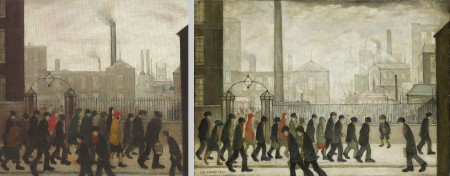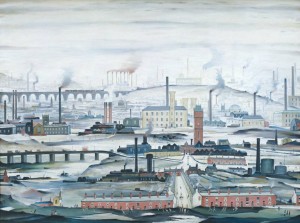This weekend’s bit of culture was a visit to Tate Britain. Heading there to meet up with some WAY friends in order to see the Lowry Exhibit Heather, Gemma and I got there early to have a bit of a look around the main galleries.
Tate
Henry Morre piece in Tate Britain
Reclining Figure
Moving away from that strangeness it was calming to walk through the displays of Henry Moore, particular liking the 1951 Reclining Figure plaster model. There were also a couple by Barbara Hepworth we liked (such as Pelagos).
As we wandered around more there was something of a Lowry preview to make us smile. I also enjoyed the calming 1932 (painting) by Ben Nicholson and, as usual, Equivalents for the Megaliths by Paul Nash.
Lowry
Coming Home From The Mill by L. S. Lowry
Coming Home From The Mill
The first thing to note about the exhibition is that it is sizeable. Six good sized rooms, the walls lined with pieces almost exclusively by Lowry. By the end of room six it’s probably all becoming a bit much. To say Lowry has a certain style is an understatement, a look repeated in piece after piece. Nowhere is that steady vision more apparent than in two pictures hanging side by side (“People Going to Work” and “Returning From Work”). Both have a backdrop of the same gates, ostensibly with people either coming or alternatively going but in each heading the same way, with some figures almost copying directly across from one painting to the other in close facsimile. This repetitiveness means the most interesting room is possibly the one that isn’t all Lowry but contains other pieces of the time to compare and contrast too; I think a little more of that would have been nice.

Comparison of People Going To Work and Returning From work
Comparison of Lowry’s People Going To Work (1929, left) and Returning From Work (1934, right)
Industrial Landscape (1955) by L. S. Lowry The Funeral by L. S. Lowry (1928)-
Industrial Landscape 1955

The Funeral
a world from which vegetation had been banished; nothing existed except smoke, shale, ice, mud, ashes and foul water
to take part of the Road to Wigan Pier quote which adorns one wall). In The Funeral has not one spot of colour other than the figures in the foreground, outside the graveyard, passing by the death and grimness of the world.
And there is the nub of it for me. While Lowry’s world is unrelentingly bleak his figures rarely are, except where that world has caught up with them. That world may be grey and grim at times but they, we, are not; and neither was Lowry.
More Tate
A sudden give away in the Chapman Family Collection
Scary!
More classically The Girl at the Gate looked familiar for some reason. Photography also got noted, mainly some of Bill Brandt‘s works, including the very good Nude London, 1952 (good job Gemma didn’t see me looking at that!)
Then there was no time left, so off home again it was. Tate Modern is probably next.
Comments and Pings